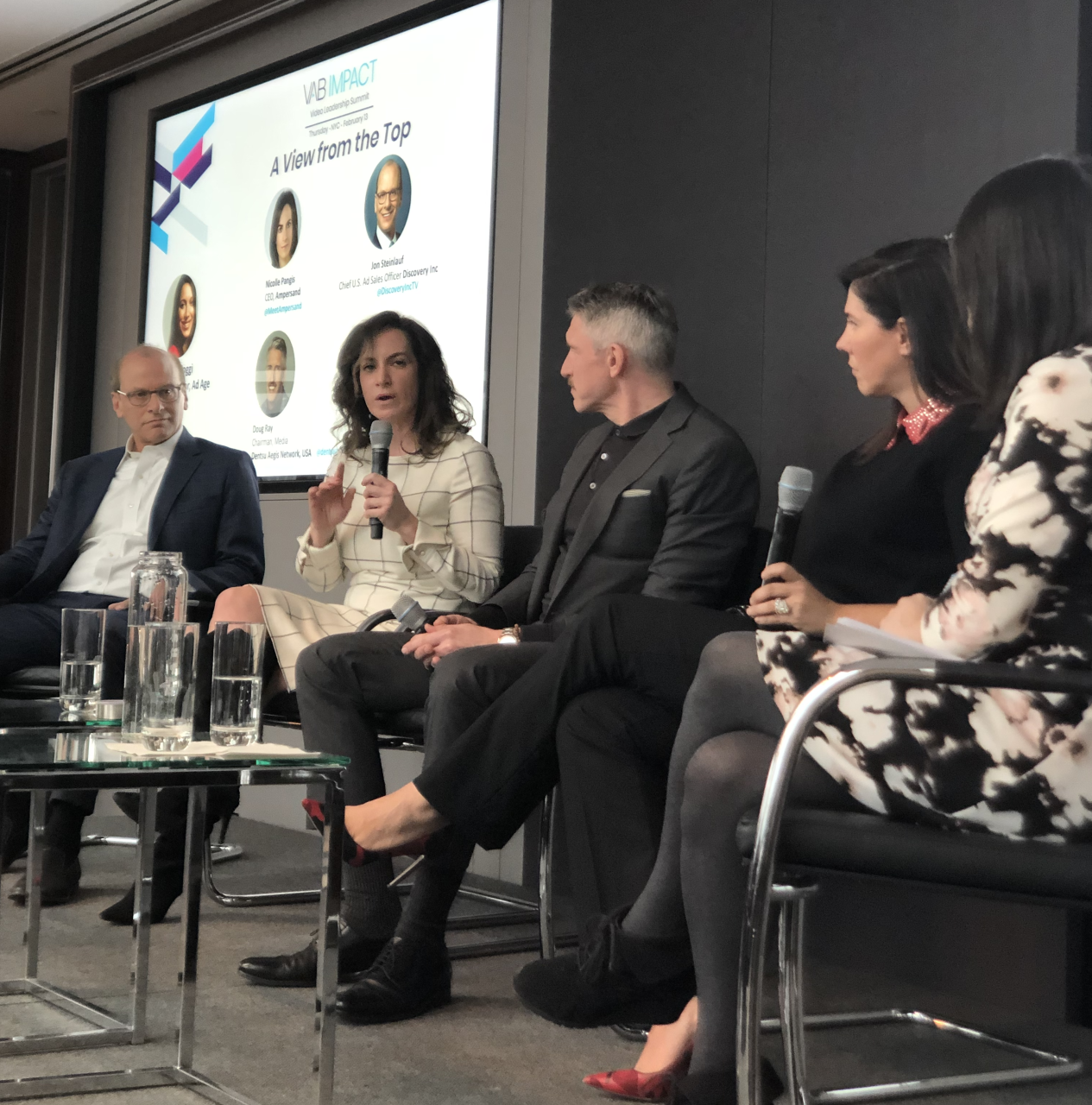Addressable and Attribution: Talking Through Challenges at VAB

Television may be described as a "lean back" medium, but the media industry audience at the VAB's Impact conference last week was definitely "lean in."Along with the appeal of pedigreed panelists — such as Jon Steinlauf, chief U.S advertising sales officer for Discovery Inc., and Xandr chief revenue officer Jason Brown — panel topics were curated to drive interest: maximizing client business results, attribution challenges, "streaming wars," and DTC strategies. The through lines for the day? That the video industry has to join forces in common terminology and measurement, as well as in finding a balance between data and creative.
The first two sessions of the half-day event delved deep into topics frequently scrutinized these days: addressability and attribution. The sentiment is that — whether linear or digital — TV is composed of content and distribution, and we should be able to measure it and hold it accountable. So, where do the stumbling blocks remain?
Offering one of the "Views from the Top," as the kick-off panel was titled, Doug Ray, chairman, media, of Dentsu Aegis Network USA, acknowledged that even while streaming subscribers have surpassed pay subscribers, it's an "opportunistic time period" for those who solve for deficiencies. The Dentsu Aegis approach is to help clients understand the landscape, including the need for a broad view of video. The agency also helps them identify unduplicated reach, which, he said, correlates to household penetration and incremental sales.
This education is an ongoing effort. "There aren't enough clients that are seeing the holistic opportunity" Ray added. Many are looking at things the wrong way, he said, "still focused on, say, the CPM of OTT or the CPM of addressable TV and saying, 'That's too expensive' versus cable or other channels."
Nicolle Pangis, chief executive officer of Ampersand, took a sidebar on semantics, saying that "streaming" or "pay" aren't different; they're TV, just delivered differently. "My kids don't ask when they're watching, 'Hey, is this linear?'" she said. She also pointed out that "brands will lean in wherever there's the most audience with scalability and measurement."
Lisa Valentino, executive vice president of client and brand solutions, at ABC Disney, agreed that TV isn't an either/or. She stressed that "we do have to be careful not to make this a race to the bottom" between linear and digital, and instead focus on how to connect and measure all screens.
Discovery's Steinlauf offered a well-formed prediction and an imperative for "lighter loads, targeted ads, ... and targeted content." That teed up reference to Discovery's 60,000-episode television library. "If we fire up a good algorithm on that content," he explained, "we make the experience much more personalized. [So,] if you love animals or science or cars or Oprah Winfrey content, there's going to be an engine that can program that service for you the way music is programmed."
Diving deeper into ad loads, Dentsu Aegis's Ray was fervent about the challenges of inventory and yield. "The only way to lighten that load and maintain revenue is to be able to enable more inventory that's available," he said. "We've got to move away from considering reaching the audience within a narrow footprint of content that is available.... [Instead, ask] what are the streaming ad-supported opportunities, the other formats and video opportunities that exist in that portfolio, and how do we think about the ads traveling across all of that?"
All were in agreement on the need for advertisers to embrace all viewership options. They also concurred that there's a need to fill in for underexposed audiences through addressability, which everyone also agreed is still fairly nascent. "I'm sort of starting to feel about addressable the way I feel about the word programmatic, which means something so specific in so many people's minds," said Steinlauf, adding that it's not always positive. "For now, addressable means DirectTV. It means highly targeted, interactive for marketers who want to have a 17-minute engagement with a household. And I think we've got to change that."
Steinlauf noted that it's time to bring data-led and tech-enabled capabilities to video. "Addressable TV or advanced TV is a way to complement the holistic approach to video," he said. "We've got some nomenclature that comes with baggage … but, really, what is the underlying capability that's enabling us to do things better, to do the best practices that we've always known works for building brands?"
Ampersand's Pangis was plain-spoken on what else is needed. "More interactive ads and ways to interact with advertising are essential, as these days the consumer expects to be able to do something about something that they see," she said. "TV should always be, will always be, the best way to build brands. People can't react to an ad even when targeted to them if they don't know that the brand exists to begin with."
Other challenges — primarily attribution — were the focus of the next panel. Whether with the aid of deduplicated reach or audience propensity, sales success would, ideally, be able to be attributable to TV, with the marketer selling more product, thus spurring more investment back into the medium and creating a virtuous cycle. Xandr's Brown pointed out that "you can put together a customer journey that's scalable and repeatable and takes all the effort out of your way." So, that is realistic today. The other reality, though, is that marketers still want an "uber clearing house single platform with all consumer data, all inventory, pricing, and more and that is complicated and aspirational right now," he added.
Brown told MediaVillage after the conference that "we are starting to see some positive movement toward audience-based planning and buying." He attributes that to more robust data enablement "and better tools that allow brands to execute full customer journey media activations." On the panel, Brown had noted the numerous agencies acquiring and investing in large data companies, aimed at helping drive the creation of people-based planning tools. Offline he added that, "One factor fueling this movement is persistent identity, and a complete understanding of the customer journey to power intelligent advertising, in a way that's more relevant for consumers."
Counted solidly among companies that have good identity data is AT&T, which has "a billing relationship with about a third of the population across TV mobile and broadband," Brown said. AT&T can use that data, he added, "to identify the most relevant customers, and even manage frequency within that AT&T world." However, as fellow panelist Ken Norcross, director, business development, of Inscape, pointed out, like other aspects of advanced TV, there is still a need for educating marketers and explaining the underlying data and what they're being measured against.
For panelist Roseann Montenes, vice president, precision and strategic audiences sales partnerships at A+E Networks, whether it's precision, performance, or a combination of it all, the network's true north is "if marketers are winning … we're all winning."
Don't stop now! Stay in the know on audio/video trends with more from E.B. Moss.
Click the social buttons to share this story with colleagues and friends.
The opinions expressed here are the author's views and do not necessarily represent the views of MediaVillage.com/MyersBizNet.


